Table of Contents
If you are in the UAE or have had the chance to live there, you must have noticed the richness in the culture and tradition of this country. Despite the advancement in technology and tourism, the UAE has not failed to place so much value on their culture and history.
Some historical facts, moments, and figures are all preserved in various ways to remind the people of how it all started. This is also to commemorate the labors of their past heroes. The country’s deep historical roots and strong national identity also play a key role in shaping its modern economy and business environment. For those considering business setup in UAE, understanding the local culture can be valuable in building successful professional relationships.
So in this article, I will explain to you what the symbols represented on the UAE currencies mean. But first let's know what the UAE currencies are called.
- Top 30 business ideas in Dubai for 2025
- How to get a mortgage in the UAE
- Ejari typing centers in Dubai: services, locations and more
- How to Start a Vending Machine Business in Dubai: A Complete Guide 2025
- Moving to Dubai from Germany: 2025 Guide
- Esaad Card for UAE Golden Visa holders
- How to Get Argentine Citizenship in 2025
- How to File for Divorce in the UAE
- UAE Visa Guide for Qatar Residents
- How document clearing services work in Dubai
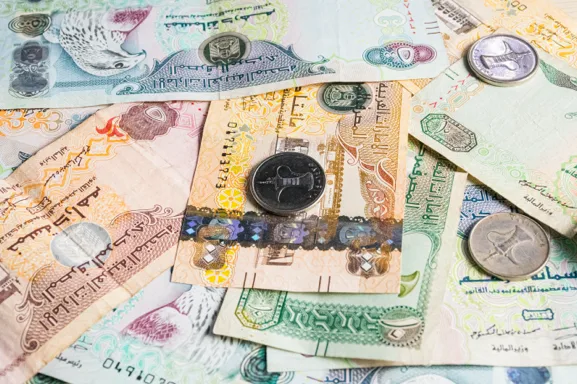
UAE Dirham
The UAE currency is called Dirham. It is represented in either “Dirhams” or “Fils”. The UAE Dirhams symbol is “DHS” or most commonly known as “AED”.
Today the UAE paper currency starts from Dhs 5 down to Dhs 1000 while there are 3 denominations of the UAE coins; 20 Fils, 50 Fils and Dhs 1.
Symbols of the UAE Coins
The UAE currency coins are represented in three denominations which are called the “Fils” except the Dhs 1. So basically, there are just 25 fils and 50 fils. In the front side of the UAE coins you can see some historical symbols while the back side is simply an inscription of both the English and Arabic version of “United Arab Emirates”. Ok, so let's move forward to know about those symbols imprinted on the United Arab Emirates coins.
25 Fils - an Arabian Sand Gazelle
This is the smallest currency coin in the UAE which is in a circular form. In the 25 Fils you can see an Arabian sand gazelle which is usually found in the desert of the UAE.
This animal that looks like an antelope is a major wildlife and a native of the UAE. It is believed that the UAE contributed massively to its growth in population to other regions.
50 Fils - Three Standing Oil Derricks
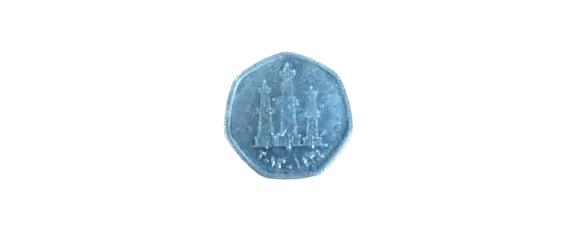
Derricks are machines used to raise heavy objects. So these three oil derricks symbolize oil as a major aspect of the economic upliftment of the UAE. The discovery of oil started in the 1950s while the export commenced in Abu Dhabi in 1962. Before 1952, the 50 fils was round in shape but now its heptagon (7 sides).
Dhs 1 - a Local Tea Pot (Dallah)
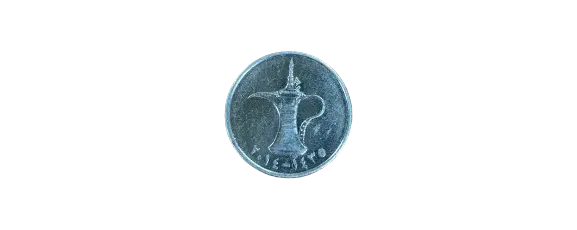
A traditional tea pot is represented in the UAE Dhs 1. This symbolises hospitality and friendliness. Tracing back to history, the UAE has been marked with great reception and friendliness towards guests and strangers
So, this strong aspect of the local culture was imprinted on their currency to keep reminding everyone of the country’s cultural heritage. This also encourages any guest or stranger in the UAE to feel at home.
Symbols of the UAE Banknotes
The UAE bank notes start from the Dhs 5 which is the least of the paper currencies. Again, the UAE paper currency has historical symbols and Arabic writings on each note while the other side of the note also contains symbols and English writing. So, we start from Dhs 5 to the highest which is Dhs 1000.
Dhs 5 - the Blue Souq (Arabic side)

The blue souq is also known as the Central Market which is a massive place for trading and shopping in Sharjah. It was constructed in the year 1979 with the best of Arabic designs for beautification. This can be spotted on the Arabic side of the currency note.
The Blue Souq has become a massive center of commerce in Sharjah with more than 500 shops to showcase various market products and activities.
Dhs 5 - Salem Al Mutawa (English side)
The other side of the dhs 5 is a mosque called Salem-Al-Mutawa in the Emirate of Sharjah. It is one of the two oldest mosques in the UAE and was formerly called Al- Jamaa. It is believed to have existed for 200 years.
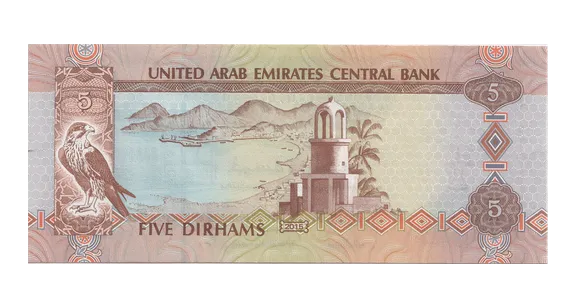
The other side of the dhs 5 is a mosque called Salem-Al-Mutawa in the Emirate of Sharjah. It is one of the two oldest mosques in the UAE and was formerly called Al- Jamaa. It is believed to have existed for 200 years.
Dhs 10 - a Curved Dagger Khanjar (Arabic side)
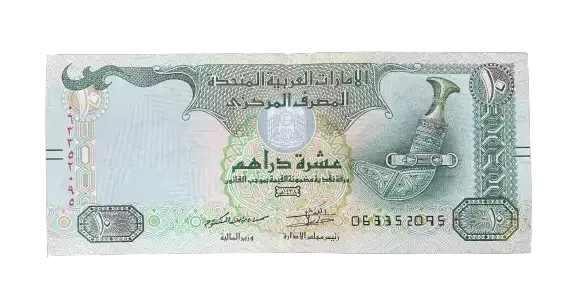
This was used for ceremonial purposes in the older days of the Arabic tradition. It was mostly worn by the men from Oman and the UAE for self protection and for hunting. So this dagger stands to symbolize “protection and security” in the UAE and it can still be found today in some Arabic markets. This is shown in the Arabic side of the Dhs 10 currency note
Dhs 10 - Date tree (English side)
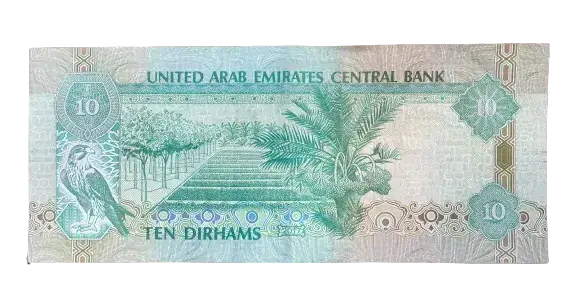
On the English side of the Dhs 10 is a date tree with various bunches of fruits. In the older days of this Arabic nation, the date fruit was a major source of sustenance. Today it's also a massive source of economic advantage to the nation. It symbolizes sustainability.
Dhs 20 - Dhow Boat on the Sea (English side)
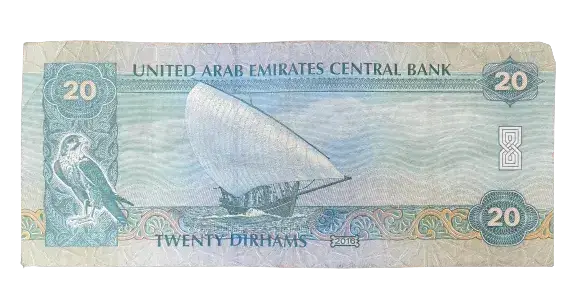
This is imprinted on the Dhs 20 to symbolize how fishing and sailing were the only reliable means of livelihood and commerce in the older days of the Emiratis. It is shown on the UAE Dirham currency note to remind the people about major ancient means of survival before the discovery of oil. A picture of the Dhow on the sea was captured in the year 1973. This is found on the English side of the currency note.
Dhs 20 - Dubai Creek Golf and Yacht Club (Arabic side)
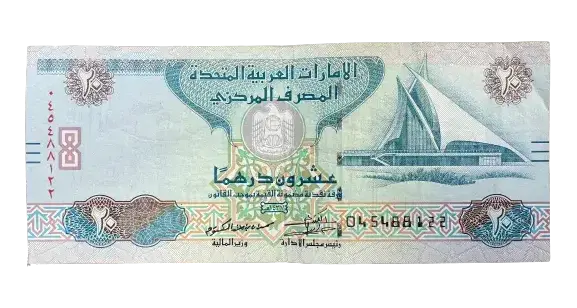
On the Arabic side of the currency note you can see the popular Dubai Creek Golf and Yacht Club. It was built in 1993 but was redesigned in 2004. It hosted the first golf academy ever to function in the Middle East. Currently, a lot of fun and touristic activities take place there. It is a great place for tourists.
Dhs 50 - An Oryx (Arabic side)
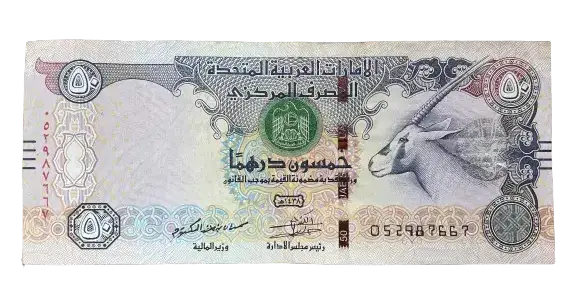
Just like the sand Gazelle portrayed in the Dhs 5, the Oryx drawn on the Dhs 50 is a specie of antelope that is considered also native to the UAE. It can be found in the desert of the UAE. It is one of the national animals held with much pride. So, this symbolizes the nation's warm relationship towards wildlife. This is shown on the Arabic side of the bank note.
Dhs 50 - Al Fahidi Fort (English side)
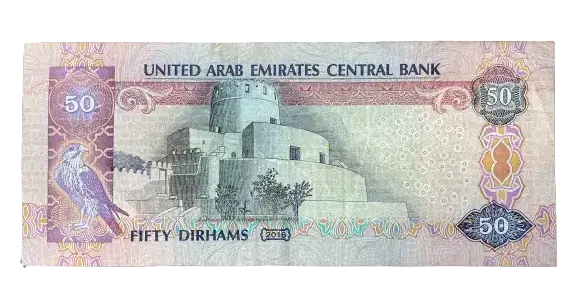
This is a very old structure built in 1787. Since then, it has served various purposes, from being a residential place of the monarch to the military weapon storehouse. At some points it was used as a prison house for the fugitives. It was also a strong place of defense and refuge. A picture of the Fahidi Fort reminds people of the constant effort that led the nation to its current progressive state. It serves presently as a fully adorned museum in Dubai with the display of rich cultural heritage and historical facts.
Dhs 100 - World Trade Centre (English side)
The World Trade Center tower was a one-time tallest structure in the UAE. It was fully constructed in 1979 and was officially opened by Queen Elizabeth II that same year. According to history it was owned by Sheikh Rashid, and today it is used for various social and cultural exhibitions as well as events. It has many commercial offices in it too.
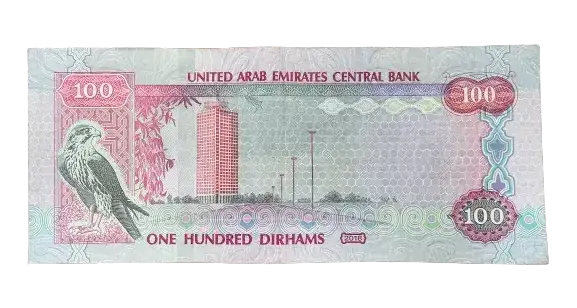
Dhs 100 - Sheikh Zayed Bridge, Abu Dhabi (English side)

This bridge with a fascinating view was built in 2010. The picture was imprinted on the English side of the Dhs 100 in 2019 which is known as the year of Sheikh Zayed. This particular type of Dhs 100 is still in circulation with “ Year of Zayed” witten on the Arabic side of the currency note.
Dhs 200 - The Central Bank of the UAE (English side)
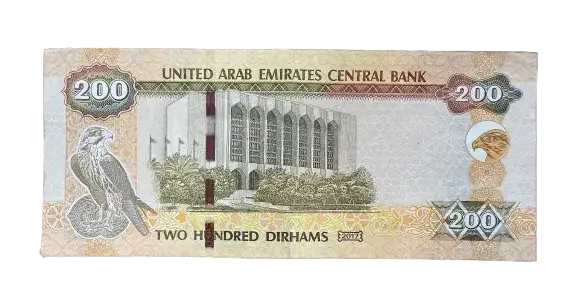
Established on the 19th of May 1973, the Central Bank is the national financial institution for managing financial matters and currencies. So, having the national monetary wealth and policy in preservation, it is considered worthy to portray in the currency, the Dhs 200 in particular.
Dhs 200 - The National Stadium, Zayed Sports City, Abu Dhabi (Arabic side)
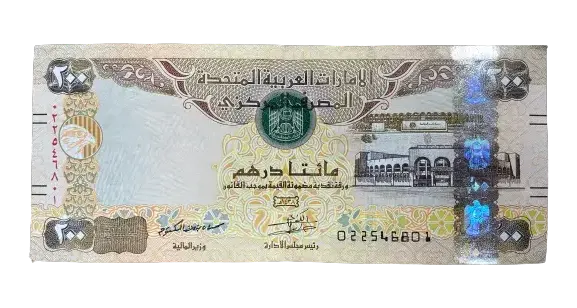
This is shown on the Arabic side of the Dhs 200 note. It was built and inaugurated in 1979 by the late Sheikh Zayed, the father of the nation and first president of the UAE. The National Stadium is the largest sports stadium in the UAE. It has a capacity of 45,000 seats.
Dhs 500 - Falcon
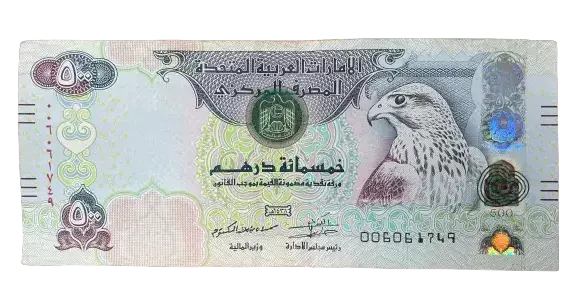
If you have ever been to the UAE, there's no doubt you must have noticed how much value the Emiratis place on the falcon. The falcon is the UAE's first bird which is displayed on the national emblem and in all the national currency notes. Looking at all the UAE currency bank notes you can see the Falcon printed by the side, but it is fully shown on the Dhs 500.
So Falcons are highly valued because of their profound intelligence and their great hunting abilities as they were used to hunt and catch prey for their keepers without killing them. Falcons helped people to survive in the desert not so long ago. It symbolizes strength and pride of the nation.
Dhs 1000 - Qasr Al Hosn (Arabic side)
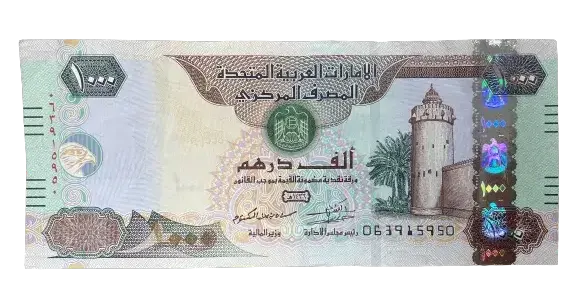
Qasr Al Hosn is an ancient watchtower in Abu Dhabi where Sheik Zayed was born. Just as the name implies, it was built as a point of security for the territory. It also acted as a residence for the royal families. But currently, the Qasr Al Hosn serves as a beautiful museum with many historical figures to behold.
Dhs 1000 - The UAE Skyscrapers (English side)

The English side of the Dhs 1000 displays the magnificent view of the country with skyscrapers. It indeed signifies in full glory how tall the UAE has stood to conquer all hindrances to the current progress. The picture was taken in 1998.
So finally, we have come to the end of this great tour of the national historical figures imprinted in the UAE currency. It is really appealing to know that despite the advancement in modernisation, the UAE still has so much reference to their traditional heritage.

Elena O.
Got a question? Our expert is ready to help!
We will contact you within 1 business day to analyze your case, provide solutions, and calculate costs.
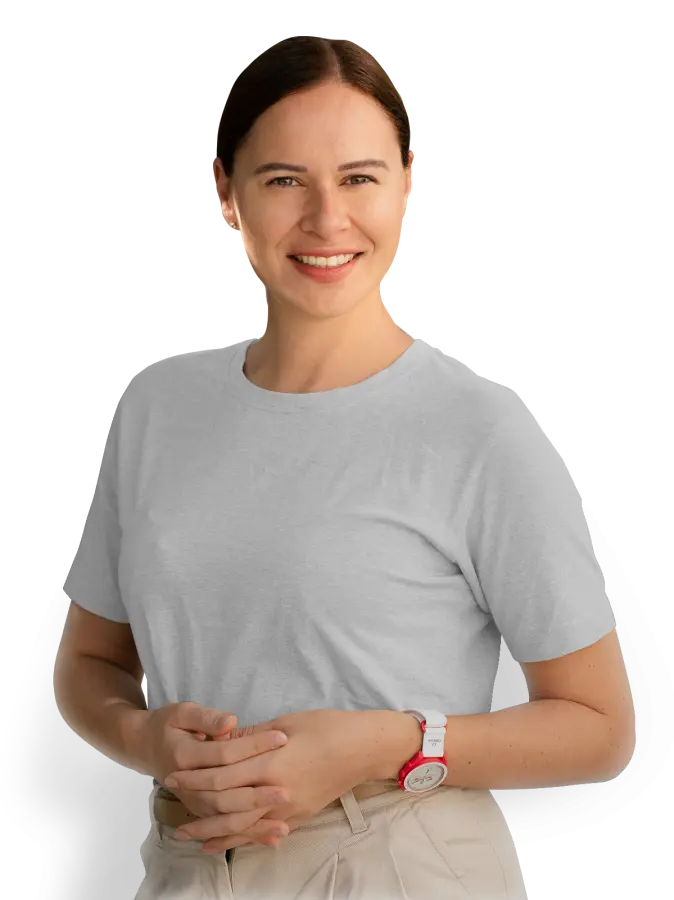






Smooth and speedy process from the initial contact to the final visa approval. Wale was super helpful and professional and always answered promptly all my questions.
Emirabiz is a red carpet service worth paying for and I want to thank Helen and her team for her dedicated support and her amazing follow-through. To launch a business in UAE and get…
Hi, I am Eric, from France. I am very satisfied by the work performed for me by Emirabiz. I was based in Saudi Arabia last year and I wanted to create my Company in UAE. I did everything…
Local Consultancy is quite simply excellent at what they do and the services that they provide. Business owner Elena is completely hands on, looking after my needs as a client personally,…
Strongly recommended! I needed to setup a company in the free zone and I ended up in the right place. Natela and Natalia were super helpful in assisting me in the process from the beginning…
Amazing company to work with. Very fast and efficient. Got all of our Paperwork done and visas + Emirates IDs in a very timely manner. Princess was wonderful and always followed up with me…
It's one of the best services that I received. I keep my relationship with this company for years now. Everything from Visa or Company related matters are resolved here with a very little…
From a scale from 0-10 in which 10 is out if this world amazing, Timi and her team deserve a 11! I decided to move to Dubai with my family and Working with Timi was by far the best decision…
Emirabiz Consultancy has consistently provided reliable and outstanding service for my visa renewal needs. I've been working with them for years, and I am very happy and satisfied with…
I worked with Timi on my golden visa process and she did an amazing job. Everything went smooth and fast! Highly recommend!
Assisted me in obtaining my Golden Visa. A big thank you to Parul Parikh for guiding me through the process and for ensuring that my application was successful. Craig
I had a wonderful experience with Emirabez. Parul Parikh helped in doing my Golden visa. It was completely smooth and hassle free. It was done very quickly. Parul was very cooperative and…
I'd like to thank Mrs. Parul from Emirabiz who has helped me sort out the UAE Residency paper for me. She was incredibly professional, very responsive, knowledgeable about the process, and…
Thank you very much for your service. All was done in a short time and in a very comfortable conditions. The level of Anna Soloviova is high. All her explanations and details of new company…
Your Service was fantastic and flawless! And a very, very special „Thank You“ for Nadia! She provided assistance to solve problems, responded immediately to E-Mails, amazing customer…
I am satisfied with the process, steps and speed of my company incorporation also you helped me a lot and very quickly.Turkey
Hi, I meet Natalia Consultant she help me a lot for my business information with quick response great job Natalia.Pradeep, Sri Lanka
We were considering options for opening a company in one of the free zones in the UAE and sought preliminary advice from Emirabiz. Consultant Natalia provided the most complete information…
I contacted Emirabiz for help in choosing and registering a company in a free zone in the United Arab Emirates. Natalia Maslina, a Business Setup Advisor, provided me with comprehensive…
So First of all thank you so much for your continuous help and quick reply for all my questions and doubts about the formation and setups. Also I am recommending this company for everyone…
I would like to acknowledge an outstanding customer service and comprehensive business development advice provided to me by Natalia. Her high level of professionalism and thoughtful…